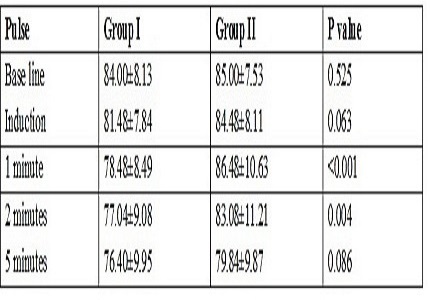Hemodynamic Responses and intubating conditions in laryngeal mask airway insertion a comparative study of propofol versus sevoflurane
Abstract
Background: LMA is an effective alternative to the endotracheal tube for securing the airway in short surgical procedures. Propofol is a widely used anaesthetic agent for the insertion of Laryngeal Mask Airway. Sevoflurane is a volatile anaesthetic agent, which combines rapid, smooth inhalational induction of anaesthesia with rapid recovery, making it ideal for day care anaesthesia.
Objective: To study if the use of sevoflurane can be used as an alternative to IV propofol for laryngeal mask airway insertion.
Primary objective: Hemodynamic responses during Laryngeal mask insertion.
Secondary objective: Intubating conditions during laryngeal mask airway insertion.
Study design: A Randomized control trial.
Methods: 100 adults were allocated by randomization into two groups of 50 each; group P (Propofol) and group S (Sevoflurane). Patients in group P were induced with 2.5mg/kg intravenous propofol with 50%O2 & 50%N2O and in group S with 8% sevoflurane in 50%O2 & 50% N2O vital capacity breath technique. Laryngeal mask airway was inserted after adequate jaw relaxation was attained and hemodynamic responses like pulse rate, blood pressure were monitored. The grading of conditions for laryngeal mask airway insertion and number of attempts were noted. All the data collected was analysed statistically.
Results: We observed that more number of attempts were required for LMA insertion in Group S (14.0%) compared to Group P (0.0%) which is statistically significant with P=0.012. Heart rate at one minute and 2 minutes after LMA insertion showed a fall with Propofol which was statistically significant as compared to Sevoflurane. There is a significant difference of fall in mean arterial blood pressure in group P during induction, one minute, 2 minutes and 5 minutes when compared between the two groups. Sevoflurane took longer time for induction and LMA insertion compared to Propofol which is statistically significant. Moderate patient movement were noticed in 5 patients of group S and no patient movement were noticed in group P and is statistically significant (P – 0.022). Quality of insertion with propofol was excellent in all patients. With sevoflurane quality of insertion ranged from excellent to satisfactory.
Conclusion: Sevoflurane is associated with good hemodynamic stability but intubating conditions provided with propofol is superior. Prolonged time for jaw relaxation with sevoflurane when compared to propofol may delay laryngeal mask airway insertion. Quality of insertion with propofol was excellent in all patients. With sevoflurane quality of insertion ranged from excellent to satisfactory.
Downloads
References
Robert G Krohner, Sivam Ramanathan . Anatomy of airway in Benumofs airway management 2nd edition.2006; 1–19, 476–497, 1027–29.
Bogetz MS. Using the laryngeal mask airway to manage the difficult airway. Anesthesiol Clin North America. 2002 Dec;20(4):863-70.
Koppula R, Shenoy A. Comparison of sevoflurane with Propofol for LMA insertion. Journal of Anaesthesiology and Clinical Pharmacology, 2005, 21(3), 271-274.
Molloy ME, Buggy DJ, Scanlon P. Propofol or sevoflurane for laryngeal mask airway insertion. Can J Anaesth. 1999 Apr;46(4):322-6.
Ti LK, Chow MY, Lee TL. Comparison of sevoflurane with propofol for laryngeal mask airway insertion in adults. Anesth Analg. 1999 Apr;88(4):908-12.
Thwaites A, Edmends S, Smith I. Inhalation induction with sevoflurane: a double-blind comparison with propofol. Br J Anaesth. 1997 Apr;78(4):356-61.
Smith, C. E., Lever, J. S., Sawkar, S., Pinchak, A. C., & Hagen, J. F. Sevoflurane-N2O versus propofol/isoflurane-N2O during elective surgery using the laryngeal mask airway in adults. Journal of Clinical Anesthesia 2000, 12(5), 392-396.
V Priya, Divatia JV, Dasgupta D. A comparison of Propofol versus sevoflurane for laryngeal mask airway insertion. Indian Journal of Anaesthesia, 2002, 46(1), 31-34.
Ganatra SB, D’Mello J, Butani M, Jhamnani P. Conditions for insertion of the laryngeal mask airway, comparisons between sevoflurane and Propofol using fentanyl as a co-induction agent. A pilot study. European Journal of Anaesthesiology, 19, 2002, 371-375.



 OAI - Open Archives Initiative
OAI - Open Archives Initiative


